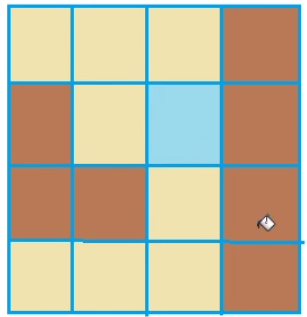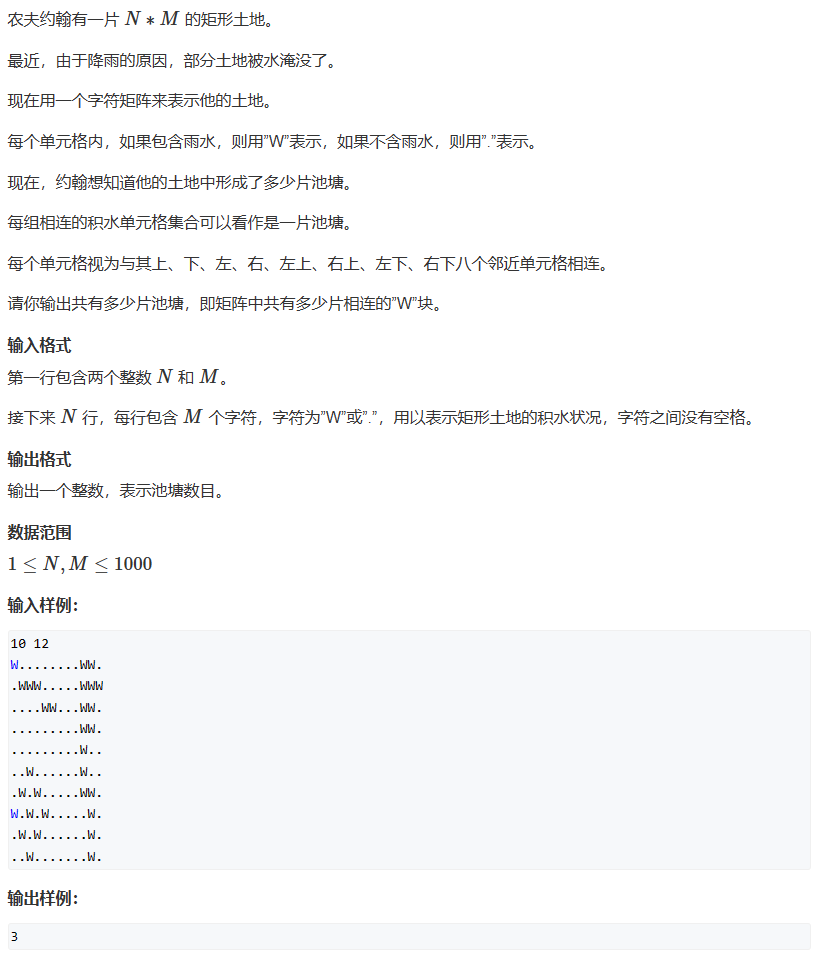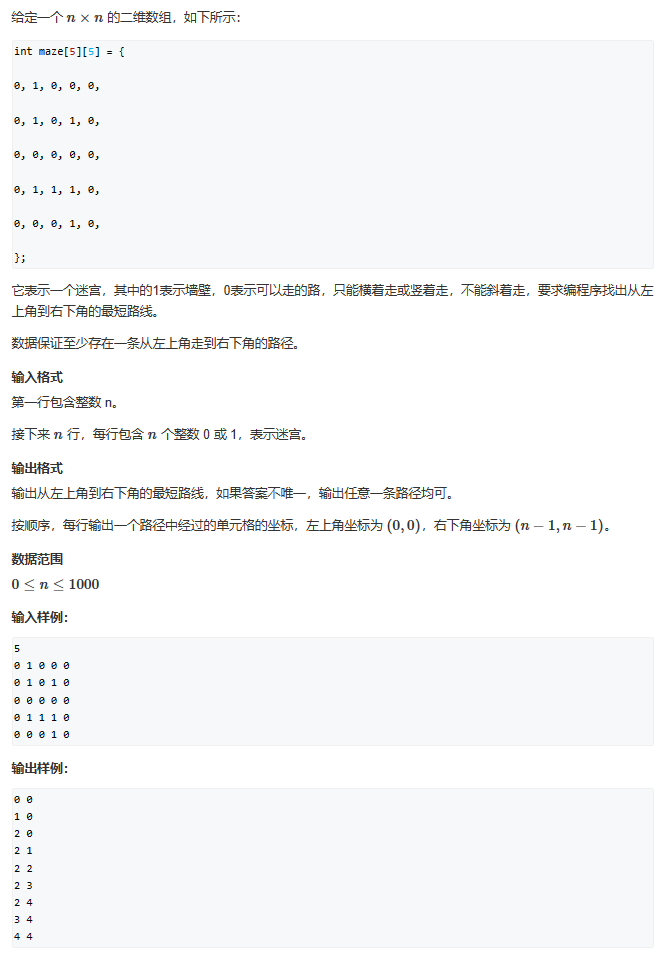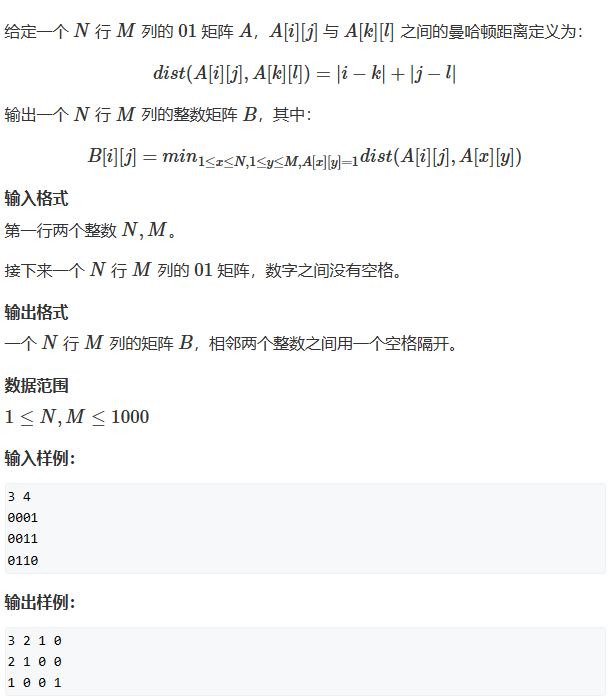BFS(一)
模型一:Flood Fill
Flood Fill 模型:洪水覆盖算法,如下图,浅色是低谷,深色是高山,我们选定一个蓝色的点为水源,模拟每一次水源覆盖的过程。

题目

本题目小技巧:如果是走四周八个方向的话可以使用一下的代码:
1
2
3
4
5
6
7
8
| for(int i = -1;i <= 1;i++)
for(int j = -1;j <= 1;j++){
int tx = x.x + i,ty = x.y + j;
if(!(tx >= 1 && tx <= n && ty >= 1 && ty <= m && !stu[tx][ty] && g[tx][ty] == 'W')) continue;
if(i == 0 && j == 0) continue;
queue[++tt] = new Pair(tx,ty);
stu[tx][ty] = true;
}
|
代码
1
2
3
4
5
6
7
8
9
10
11
12
13
14
15
16
17
18
19
20
21
22
23
24
25
26
27
28
29
30
31
32
33
34
35
36
37
38
39
40
41
42
43
44
45
46
47
48
49
50
51
52
53
54
55
56
57
58
59
| import java.io.*;
import java.util.*;
class Main{
public static int N = 1010,n,m;
public static char[][] g = new char[N][N];
public static boolean[][] stu = new boolean[N][N];
public static Scanner sc = new Scanner(System.in);
public static void dfs(int sx,int sy){
Pair[] queue = new Pair[N*N];
int hh = 0,tt = -1;
queue[++tt] = new Pair(sx,sy);
stu[sx][sy] = true;
while(hh <= tt){
Pair x = queue[hh++];
for(int i = -1;i <= 1;i++)
for(int j = -1;j <= 1;j++){
int tx = x.x + i,ty = x.y + j;
if(!(tx >= 1 && tx <= n && ty >= 1 && ty <= m && !stu[tx][ty] && g[tx][ty] == 'W')) continue;
if(i == 0 && j == 0) continue;
queue[++tt] = new Pair(tx,ty);
stu[tx][ty] = true;
}
}
}
public static void main(String[] args){
n = sc.nextInt();
m = sc.nextInt();
int res = 0;
for(int i = 1;i <= n;i++){
String s = sc.next();
for(int j = 1;j <= m;j++) g[i][j] = s.charAt(j-1);
}
for(int i = 1;i <= n;i++)
for(int j = 1;j <= m;j++)
if(!stu[i][j] && g[i][j] == 'W'){
dfs(i,j);
res++;
}
System.out.println(res);
}
static class Pair{
int x;
int y;
public Pair(int x,int y){
this.x = x;
this.y = y;
}
}
}
|
模型二:最短路模型
这个题目其实就是最经典的bfs求最短路
题目

代码
1
2
3
4
5
6
7
8
9
10
11
12
13
14
15
16
17
18
19
20
21
22
23
24
25
26
27
28
29
30
31
32
33
34
35
36
37
38
39
40
41
42
43
44
45
46
47
48
49
50
51
52
53
54
55
56
57
58
59
| import java.io.*;
import java.util.*;
class Main{
public static int N = 1010,n;
public static boolean[][] stu = new boolean[N][N];
public static int[][] g = new int[N][N];
public static Pair[][] step = new Pair[N][N];
public static Scanner sc = new Scanner(System.in);
public static void bfs(int sx,int sy){
int[] dx = {0,1,0,-1},dy = {1,0,-1,0};
Pair[] queue = new Pair[N*N];
int hh = 0,tt = -1;
queue[++tt] = new Pair(sx,sy);
stu[sx][sy] = true;
while(hh <= tt){
Pair u = queue[hh++];
int x = u.x,y = u.y;
for(int i = 0;i < 4;i++){
int tx = x + dx[i],ty = y + dy[i];
if(tx < 1 ||ty < 1 || tx > n || ty > n) continue;
if(stu[tx][ty] || g[tx][ty] == 1) continue;
queue[++tt] = new Pair(tx,ty);
stu[tx][ty] = true;
step[tx][ty] = new Pair(x,y);
}
}
}
public static void main(String[] args){
n = sc.nextInt();
for(int i = 1;i <= n;i++)
for(int j = 1;j <= n;j++)
g[i][j] = sc.nextInt();
bfs(n,n);
int x = 1,y = 1;
System.out.println(String.valueOf(x-1)+" "+String.valueOf(y-1));
while(x != n || y != n){
int tx = x,ty = y;
x = step[tx][ty].x;
y = step[tx][ty].y;
System.out.println(String.valueOf(x-1)+" "+String.valueOf(y-1));
}
}
static class Pair{
int x;
int y;
public Pair(int x,int y){
this.x = x;
this.y = y;
}
}
}
|
模型三:多源BFS
类似多源最短路问题,引入一个超级源点,连接所有源点,并且距离为1,在bfs中表示为直接往队列里面加上所有源点。
题目:

分析:
这个题目求的是矩阵中所有格子距离矩阵中任何为1的格子的最短曼哈顿距离。其实就是从每一个为1的鸽子开始bfs然后求每个格子最短的距离。这就是一个多源最短路问题,在图论中解决这种问题我们一般都是引入一个超级源点,连接超级原点和这些起点,超级原点到起点的距离为0,然后从超级源点开始像所有格子bfs。每个点得到的最短距离就是答案。
时间复杂度:O(n^3)–>O(n^2)
代码:
1
2
3
4
5
6
7
8
9
10
11
12
13
14
15
16
17
18
19
20
21
22
23
24
25
26
27
28
29
30
31
32
33
34
35
36
37
38
39
40
41
42
43
44
45
46
47
48
49
50
51
52
53
54
55
56
57
58
59
60
61
62
63
64
65
66
67
68
69
| import java.io.*;
import java.util.*;
class Main{
public static int N = 1010,n,m;
public static boolean[][] stu = new boolean[N][N];
public static int[][] g = new int[N][N],d = new int[N][N];
public static BufferedReader br = new BufferedReader(new InputStreamReader(System.in));
public static BufferedWriter bw = new BufferedWriter(new OutputStreamWriter(System.out));
public static void bfs(){
int[] dx = {1,0,-1,0},dy = {0,1,0,-1};
Pair[] queue = new Pair[N*N];
int hh = 0,tt = -1;
for(int i = 1;i <= n;i++)
for(int j = 1;j <= m;j++)
if(g[i][j] == 1){
queue[++tt] = new Pair(i,j,0);
stu[i][j] = true;
d[i][j] = 0;
}
while(hh <= tt){
Pair u = queue[hh++];
int x = u.x,y = u.y,d1 = u.d;
for(int i = 0;i < 4;i++){
int tx = x + dx[i],ty = y + dy[i];
if(tx < 1 || ty < 1 || tx > n || ty > m) continue;
if(stu[tx][ty]) continue;
queue[++tt] = new Pair(tx,ty,d1+1);
d[tx][ty] = d1+1;
stu[tx][ty] = true;
}
}
}
public static void main(String[] args) throws Exception{
String[] s1 = br.readLine().split(" ");
n = Integer.parseInt(s1[0]);
m = Integer.parseInt(s1[1]);
for(int i = 1;i <= n;i++){
String s2 = br.readLine();
for(int j = 1;j <= m;j++)
g[i][j] = (int)(s2.charAt(j-1) - '0');
}
bfs();
for(int i = 1;i <= n;i++){
for(int j = 1;j <= m;j++)
bw.write(String.valueOf(d[i][j])+" ");
bw.write("\n");
bw.flush();
}
}
static class Pair{
int x,y,d;
public Pair(int x,int y,int d){
this.x = x;
this.y = y;
this.d = d;
}
}
}
|
版权声明: 此文章版权归waar299所有,如有转载,请注明来自原作者!




